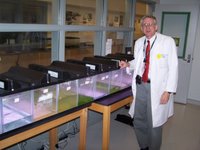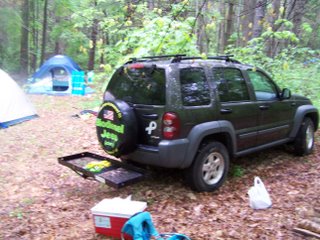
As my friend Amrita pointed out: it isn't much of a Blog if you don't update it. Sorry, but the Biofuel Family has been busy. Most importantly, it was a BIG birthday (not telling which) for my wife, so much partying and rejoicing was being planned and enjoyed. The Biodiesel Jeep has also been getting to the beach a lot, and hauling paragliders (
www.ctchutes.com) to satisfy my other non-biofuel obsessions. The little man pitched in to help clean the Jeep one hot day...note the sippy cup on the bumper.
In mechanical news, the MIL (check engine) light is still on, and I sussed out the OBD code p1104 with the help of
www.lostkjs.com forum...The Liberty Owners Special Team. This is basically Car Geek Heaven, so naturally I spend a LOT of time there learning about all that you could want to know about Libbies, diesels, nifty modifications, and other biodiesel jeepsters! This is just the sort of thing the internet does best; gets experts and enthusiast together and lets them learn from each other. If you own a specialty car, you probably already have found a similar site, The L.O.S.T. site has some really great experts floating through, so I suggest Libby owners tune in there regularly. The deciphered code indicates a very common EGR valve issue (in the exhaust/emissions system) which apparently a common issue with these Libbs and has nothing to do with Biodiesel use. So I was wrong, it was not a fuel-quality issue from when I had to fill it with NY Dino-diesel (as it was in the last time the MIL light popped. Sounded nice, though! The dealer will fix it Monday.
I'm itching to ditch my other petro-burning car. This is the one *I* end up commuting with (marital politics are VERY tricky), and it pains me each fill-up knowing I could be in a biofueled car instead. The little 2002 Ford Focus is very efficient for a production car (30+mpg) but, as you may have guessed, dino fuels just aren't my bag. I've been hunting and visiting several potential old Mercedes and VW's for a SVO (Straight Vegetable Oil fuel) project car. Why not use the Biodiesel or make my own? Well, cost is an issue, but curiosity is the bigger factor. There are expanding studies on SVO use in "tougher" diesel engines..And the data is pretty impressive. Using harvested oils directly would be a more efficient way to use the oil instead of converting it into Biodiesel...But there are many issues. I'll get into that in further posts and links, but in the meanwhile, if you are curious, visit the company with the best current research on SVO use in transportation engines is
www.elsbett.com.
Another factor is that I've been collecting and processing large amounts of waste vegetable oil (WVO) for my other experiments with home heating oil (HHO)...So I've got a lot of potential fuel sitting around. HHO is basically dirtier diesel, and in the North East HHO is a significant portion of of the total yearly petroleum use. A home furnace CAN use blends of nice thin Biodiesel&HHO without modification (Ain't Biodiesel grand?), usually a 20% blend (with a few adjustments some can burn higher consetrations of biodiesel though that isn't recommended at this time nor is it commercially available). Our current home hot water and heating furnace burns a 20% blend of Biodiesel right now...ordered and delivered from
www.halehillfarms.com. Nice and clean, no extra expense (actually, it is cheaper). But what about getting even cheaper, how about raw products? Several hefty commercial "waste oil" burners can burn substitute oils, including thick engine-oil, transmission fluid, 100% biodiesel and even vegetable oil (
www.kagiheat.com). These waste oil furnaces burn very hot and very clean and help "recycle" on the spot; this is what they do with all the oil from your fluid changes at you local mechanics/lube shop. But your home heating furnace can not use 100% waste oil, as the home burners can't take very thick oils ( and there are usually regs against it). But here's something most people won't talk about in the bio-fuels world: Biodiesel is really just thin vegetable oil. From an energy standpoint, they contain just about the same amount. Vegetable oil has more complicated fat chains and is thicker and might have more impurities...But that doesn't matter much in a furnace. You can burn dirt in a furnace. So there are groups burning 10 ,15 and 20% blends of vegetable oil with HHO, including recycled and cleaned waste restaurant oil. We ran an experiment for the last two years of up to 20% vegetable oil (virgin)without any problem. Several restaurants (including
www.angelosonmain.com) are contributing oil for further local experiments with used, filtered oil. This used oil is essentially free, so displacing 20% or expensive, dirty dinofuel is not only better for everyone's lungs..its cheap and easy. Good idea? Yep.
But don't rush and try it yet...There is a large network involved in testing these blends in a lot of furnaces across the country. Breaking car is one thing...messing up your house is different. Let us take the risk under controlled conditions with the consultation of burner manufacturers. For now, try commercial grade Biodiesel in your car, and a 20% blend of commercial grade Biodiesel in your furnace. And stay tuned!
 So far, we've displaced a total of 110 gallons of petroleum diesel in the Jeep. Feels good. We've also displaced close to 80 gallons of dino fuel in our hot water/heating furnace with various biodiesel and waste-oil blends experiments. The veg experiments in the furnace are far from concluded (there are many people working on this) but about 10-15% straight vegetable oil can be blended with regular home heating fuel (which is usually a dirty form of diesel) without much noticeable issues. There are people working to do cheap adaptations of their furnaces to run 100% veg oil, but it is experimental. 100% biodiesel can run in a furnace with usually only a nozzle and pressure change (assuming you have a modern furnace with an indoor tank)...but often a pump must be replaced with one that has seals resistant to the solvent effects of the BioD.
So far, we've displaced a total of 110 gallons of petroleum diesel in the Jeep. Feels good. We've also displaced close to 80 gallons of dino fuel in our hot water/heating furnace with various biodiesel and waste-oil blends experiments. The veg experiments in the furnace are far from concluded (there are many people working on this) but about 10-15% straight vegetable oil can be blended with regular home heating fuel (which is usually a dirty form of diesel) without much noticeable issues. There are people working to do cheap adaptations of their furnaces to run 100% veg oil, but it is experimental. 100% biodiesel can run in a furnace with usually only a nozzle and pressure change (assuming you have a modern furnace with an indoor tank)...but often a pump must be replaced with one that has seals resistant to the solvent effects of the BioD. Back in May I had the privileged to attend Biodiesel Day at the Greater Hartford Academy of mathematics & Science. At this high school, students had initiated and executed a series of projects to grow their own fuel-stock (algae) and make biodiesel. The scope of their ambition, imagination and accomplishment was staggering. This Biodiesel day was a presentation of their year's work to about 250 of their peers and faculty. Without any teacher input or suggestion, this project had been planned, managed and developed into the basis for real advancement in developing what will eventually become a primary fuel-stock process for the US and probably the world.
Back in May I had the privileged to attend Biodiesel Day at the Greater Hartford Academy of mathematics & Science. At this high school, students had initiated and executed a series of projects to grow their own fuel-stock (algae) and make biodiesel. The scope of their ambition, imagination and accomplishment was staggering. This Biodiesel day was a presentation of their year's work to about 250 of their peers and faculty. Without any teacher input or suggestion, this project had been planned, managed and developed into the basis for real advancement in developing what will eventually become a primary fuel-stock process for the US and probably the world.





